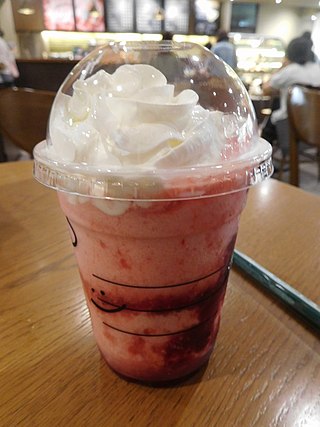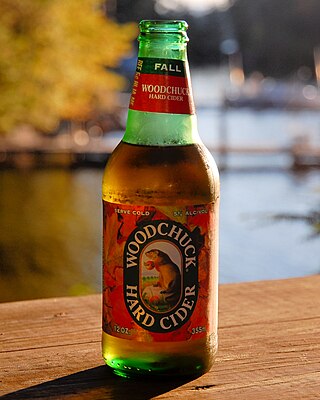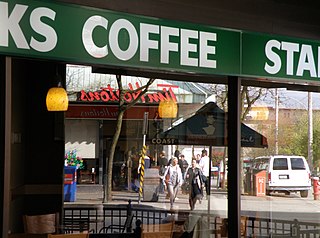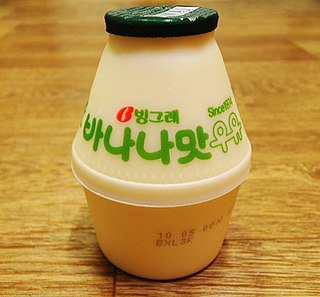
A cappuccino is an espresso-based coffee drink that is traditionally prepared with steamed milk foam (microfoam).

Starbucks Corporation is an American multinational chain of coffeehouses and roastery reserves headquartered in Seattle, Washington. It is the world's largest coffeehouse chain.

Caffè latte, often shortened to just latte in English, is a coffee drink of Italian origin made with espresso and steamed milk. Variants include the chocolate-flavored mocha or replacing the coffee with another beverage base such as masala chai, mate, matcha, turmeric or rooibos; alternatives to milk, such as soy milk or almond milk, are also used.

Frappuccino is a line of blended iced coffee drinks sold by Starbucks. It may consist of coffee or crème base, blended with ice and ingredients such as flavored syrups and usually topped with whipped cream and or spices. It may also include blended Starbucks refreshers. Frappuccinos are also sold as bottled coffee beverages in grocery stores, convenience stores and from vending machines.

Café au lait is coffee with hot milk added. It differs from white coffee, which is coffee with cold milk or other whiteners added.

Woodchuck Hard Cider is a brand of hard cider produced by the Vermont Hard Cider Company, LLC, in Middlebury, Vermont. In 2011 it was the top-selling hard cider in the United States, capturing approximately 47% of the hard cider market in the country.

The Coffee Bean & Tea Leaf is an American coffee shop chain founded in 1963. Since 2019, it is a trade name of Ireland-based Super Magnificent Coffee Company Ireland Limited. Its 80% stake is by multinational company Jollibee Foods Corporation. It operates as an independent subsidiary and remains headquartered in Los Angeles, California.

A flat white is a coffee drink consisting of espresso with microfoam. It generally has a higher proportion of espresso to milk than a caffè latte, and a thinner layer of microfoam than a cappuccino. Although the term "flat white" was used in the United Kingdom to describe a type of espresso-based drink in the 1960s, the modern flat white was developed in Australia and New Zealand.

Argo Tea began as a chain of tea cafes that was founded in the Lincoln Park community area in Chicago, Illinois, in June 2003. It was headquartered in Chicago's Loop community area. It had more than a dozen locations in the Chicago metropolitan area before expanding in 2010 to New York City, where it opened four locations that year and then expanded to St. Louis and Boston. As of October 2011 the chain had 26 locations and distribution in over 3,000 grocery stores. In its first decade, it has grown simultaneously with the tea market. Its expansion into grocery stores occurred in 2010 and 2011. Arsen Avakian is the current chief executive officer. By spring 2013, it had opened in Beirut with plans to add locations in five Middle East cities by year end.

Milk coffee is a category of coffee-based drinks made with milk. Johan Nieuhof, the Dutch ambassador to China, is credited as the first person to drink coffee with milk when he experimented with it around 1660.

Pumpkin pie spice, also known as pumpkin spice, is an American spice mix commonly used as a flavoring for pumpkin pie, but does not include pumpkin as an ingredient.
Teavana Corporation is an American tea company, which previously had locations throughout the United States, Canada, Mexico, and the Middle East. Starbucks acquired Teavana in 2012, and in 2017, Starbucks announced it would close all Teavana locations by 2018. As of 2022, a very limited variety of Teavana products continue to be sold at Starbucks.

Mazagran is a cold, sweetened coffee drink that originated in Algeria. Portuguese versions may use espresso, lemon, mint and rum, and Austrian versions are served with an ice cube and include rum. Sometimes a fast version is achieved by pouring a previously sweetened espresso in a cup with ice cubes and a slice of lemon. Mazagran has been described as "the original iced coffee".

Masala chai is a popular beverage throughout South Asia, originating in early modern Indian subcontinent. Chai is made by brewing black tea in milk and water and then sweetening with sugar. Adding aromatic herbs and spices creates masala chai, although chai is often prepared unspiced.

Coffee wars, sometimes referred to as caffeine wars, involve a variety of sales and marketing tactics by coffeehouse chains and espresso machine manufacturers to increase brand and consumer market share. In North America belligerents in these wars typically include large coffeehouses, such as Starbucks, Dunkin', McDonald's, and Tim Hortons. According to The Economist, the largest coffee war of the late 2000s was between Starbucks and McDonalds in the United States. The U.S. market has, since the early 2010s, been primarily contested by its two largest players, Starbucks and Dunkin'. Since 2020, competition over the Chinese coffee market has intensified between Starbucks and Luckin Coffee.

Pumpkin ale is a popular style of beer in the United States. Pumpkin ale may be produced using pumpkin flesh in combination with malt or other more typical beer grains as a portion of the mash bill, contributing fermentable sugars to the wort. It may also be produced by adding natural or artificial flavor to a finished beer. Spice flavor may be added to evoke the flavor of pumpkin pie, a popular American wintertime dessert.

Banana Flavored Milk is a South Korean milk beverage produced by Binggrae in Korea.
Pumpkin Spice Spam is a limited edition variety of Spam produced by Hormel Foods. It was released online on 23 September 2019, the first day of autumn. Spam is one of many brands to release pumpkin spice products for the autumn season, and is not the first meat product to be pumpkin spice flavored.

Oatly Group AB is a Swedish food company that produces alternatives to dairy products from oats, including oat milk. Oatly was formed in the 1990s using research from Lund University. Oatly has headquarters in Malmö and a production and development center in Landskrona.

















